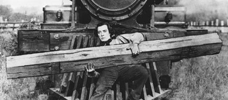Reviews
Peter MacDonald
USA, 1988
Credits
Review by Cullen Gallagher
Posted on 14 July 2009
Source Lion’s Gate DVD
Related articles
Reviews:
Categories Favorites: The Action Movie
Rambo III is a mess—an irreconcilable mélange of the awesome and the absurd, the ridiculous and the serious. Obstructing the narrative is a slew of contradictions and irregularities that break up what is otherwise a reworking of its predecessor, Rambo: First Blood Part II. But for something that tries to follow so closely the path set out by the previous two films, it is a surprisingly distinct entry in the series. I say “surprisingly” not because the other films are so cookie-cutter - in fact, if anything can be said for the Rambo cycle, it is that each entry has its own individual feel and conception of the titular character - but because Rambo emerges as a different entity seemingly against the intentions of filmmakers. Rambo III is an unwieldy beast that offers no easy, clear-cut analysis or summation, and for this the film is at once a headache and a delight, and ultimately an enigma.
The abandonment of the “First Blood” prefix is the first sign of wandering off the path, the first indication that something will be missing from the film. What’s gone is sense of Rambo having been wronged and needing to right himself. There’s no vengeance, no retaliation, no blood in this third entry. Though there is plenty of killing, much more than in previous films, it is decidedly less personal: there’s no vindictive streak that torments Rambo throughout the film, blackening and burning his soul from the inside out, until finally Rambo lets out the pent-up steam via his M-60 machine gun, the falling bullets like so many beads of sweat pouring off his muscular body. That was the Rambo of First Blood and Rambo: First Blood Part II. Six years since his cinematic inception, things have changed.
First, our introduction to Rambo in Rambo III is through a series of fragmented close-ups of his muscles, gleaming with perspiration. In previous films, the revelation of Rambo’s bare body was withheld until the main conflict was present, and in both cases Rambo was stripped by his captors and tortured. The awe-inspiring sight of his blossoming muscles was contrasted with their confinement and abuse, an image at once intensely masculine and emasculating. Here, as Rambo prepares for a stick fight in Thailand, his muscles are stripped of their complexity, instead serving as a mere signifier of his strength.
Second, Rambo is now officially “a talker.” Whereas the first two films were characterized by Rambo’s steadfast silence, broken only in the final scenes in which he delivers exhausting, cathartic speeches, this third film shows Rambo fully engaging in a conversation in just its second scene. Having traced Rambo from the stick fight to a monastery, Trautman invites his former soldier to assist him on a mission to Afghanistan to help get aide to the Mujahideen rebels in an effort to defeat the Soviet forces that control the area. “Do you really think it’s going to make a difference?” asks Rambo. “It didn’t before.” This edge of cynicism is a new side to Rambo.
The most important inversion, perhaps, is that of structure. The first two films began with Rambo lost, and the stories were his attempt to find a home—whatever that may be. In the first film, he failed. In the second, he returned to the jungle. And now, in the third, he begins with that sense of rest. “I don’t know what you think about this place,” he says to Trautman, “but I like it. I like being here. I like working here. I like belonging to something.” Having found what he set out looking for in First Blood, where does Rambo go from here?
Essentially, nowhere. There’s a decided lack of movement in Rambo’s character in this film. Trautman tries to convince Rambo that he needs to come “full circle” and realize that he is a soldier for life, but even this speech doesn’t set the foundation for any deeper exploration or transformation of Rambo, or even any real motivation for the journey that he eventually goes on. Having gone ahead with the mission without Rambo’s help, Trautman is captured by the Soviets and abandoned by the American military. So, it is up to Rambo to save him.
From here, the film tries to mimic Rambo: First Blood Part II in almost every respect, though it strips the plot of two of its most crucial aspects: the love interest, and Rambo’s capture and subsequent torture. In other words, Rambo’s vulnerability is sacrificed for his ass-kicking abilities. The large set pieces remain mostly the same (with minor variations): Rambo stalks the enemy on their own terrain, silently slaughtering them with bare hands, knife, and arrow; after an initially unsuccessful first attempt, Rambo must re-break into the prison a second time; he steals the enemy helicopter in order to escape with the prisoners, which is eventually shot down; he uses the radio to deliver a bad-ass one liner (in this case, it is, “I’m your worst nightmare,” considerably less threatening than in either of the previous films); and to make up for the unspectacular killing with machine guns and arrows, Rambo once again blows up an enemy soldier (bonus points for using the opponent’s own grenade, and managing to hang him in the process).
If the film were nothing more than this - just a casserole of action, perspiration, and violence - it would be considerably easier to wrap your head around. Among the many aspects of the film that aren’t so simple to digest are its politics, even more out-there than the previous film (if that were even possible; and as a foreshadow of things to come, the fourth film goes even further). Set during the then-current Soviet-Afghan War, the film’s ardent sympathy with the rebels is seemingly an expression of Cold War hostility against Russia (the sort of which fueled Rambo: First Blood Part II and Rocky IV). At the same time, the characterizations of the Afghani rebels are rife with clichés and stereotypes: they speak comically broken English, and are prone to use folk tales and poetic expressions at any given moment. Given that Rambo’s only real interest is in saving Trautman, regardless of the human cost (even his own life), it is worth questioning whether or not Rambo III is exploiting this political context for the sake of plot. Complicating this analysis even further is the film’s absolutely sincere closing dedication, “To the gallant people of Afghanistan.” Even Janet Maslin acknowledged such a disorienting contradiction in her New York Times review, concluding, “it clearly intends that its politics be taken seriously” while portraying “the Afghan fighters, who are this film’s noble Indians, [as] entirely one-dimensional.” Even in today’s cinema it is rare for Hollywood to handle such a timely, international topic, and for this reason alone, Rambo III stands apart from your garden-variety action film.
The other significant incongruity of Rambo III is a sudden change of mood once Trautman is rescued. Out of nowhere, the film becomes somewhat of a “buddy comedy.” If nothing else, the first two Rambo movies were completely serious about their story (regardless of how audiences interpreted them). But now, we have Rambo and Trautman seemingly acknowledging the far-fetched fiction of their story. After a near-explosion experience, Trautman asks Rambo how he is doing, to which Rambo answers, “Well done.” In another scene, Trautman asks how Rambo is dealing with the pain, and Rambo replies, “You taught us to ignore pain.” When Trautman asks how it is working, Rambo retorts, “Not really.” There’s nothing straight-faced about these lines, and they couldn’t be delivered any other way. Out of touch with the other movies as they may be, Sylvester Stallone (as Rambo) and Richard Crenna (as Trautman) are clearly having a blast delivering them. Those who have invested in their father-son relationship for the past two films can now enjoy a mature rapport between the two characters, as though they are finally equals.
Janet Maslin’s surprisingly sympathetic review actually hits the film on the head, capturing its dual solemn and comic sensibility that never straightens itself out.
Mr. Stallone has by now made Rambo parody-proof, since the character is every bit as laughable as he is grandiose; that’s part of the fun. Rambo’s self-important, weight-of-the-world manner and his taste for political posturing would make him genuinely silly were they not counterbalanced by Mr. Stallone’s startling, energetic physical presence and the film’s stabs at self-mocking humor.
First Blood and Rambo: First Blood Part II were character-oriented films, punctuated by frequent bits of action and disguised within the frameworks of fugitive- and rescue-plots, respectively. Rambo III dispenses with the larger character movement of Rambo, choosing neither to alter nor challenge the persona, but neither getting the archetype 100% accurate. It is this anomaly that differentiates the film from its predecessors, but it’s also what prevents it from reaching their same heights.
More Favorites: The Action Movie
-

First Blood
1982 -

The General
1926 -

The Running Man
1987 -

Guns
1990 -

Highlander
1986 -

Death Race 2000
1975 -

Scaramouche
1952 -

Do or Die
1991 -

Thief
1981 -

Mission: Impossible
1996 -

Invasion U.S.A.
1985 -

Rambo: First Blood Part II
1985 -

Bullitt
1968 -

Hard Hunted
1992 -

The Fugitive
1993 -

Kindergarten Cop
1990 -

Under Siege
1992 -

Dirty Harry
1971 -

Rambo III
1988 -

Public Enemies
2009 -

Day of the Warrior
1996 -

The Good, the Bad, the Weird
2008 -

Straw Dogs
1971 -

Die Hard
1988 -

Con Air
1997 -

Collateral Damage
2002 -

Rambo
2008
We don’t do comments anymore, but you may contact us here or find us on Twitter or Facebook.



